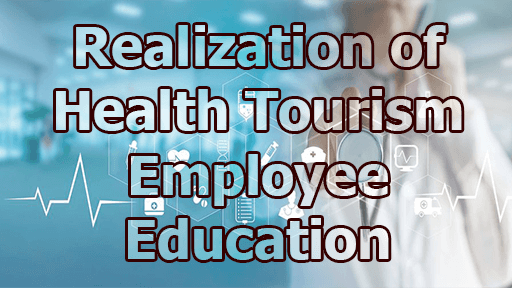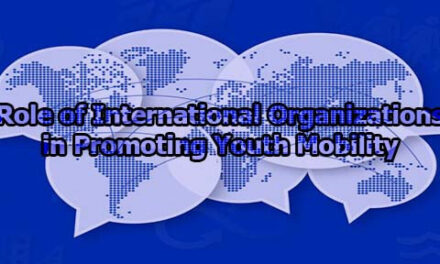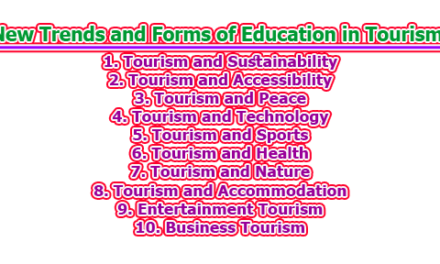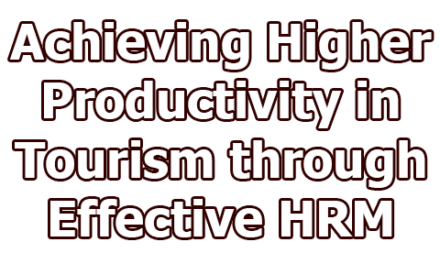Realization of Health Tourism Employee Education:
Health tourism, also known as medical tourism, is a rapidly growing global industry where individuals travel to other countries or regions to receive medical treatment, surgery, or wellness services. The appeal of health tourism lies in the opportunity for high-quality medical care at competitive prices, combined with the allure of exploring new destinations. As this industry continues to expand, the importance of educating health tourism employees becomes increasingly evident. Properly trained professionals are essential to ensure the safety, satisfaction, and overall success of health tourism experiences. In this article, we will delve into the realization of health tourism employee education, discussing its significance, key components, challenges, and potential solutions.
Section 1: The Significance of Health Tourism Employee Education:
The significance of health tourism employee education cannot be overstated, as it plays a pivotal role in ensuring the safety and satisfaction of patients seeking medical treatment abroad. This section explores the importance of health tourism employee education and provides authentic citations to support these points.
1.1 Enhancing Patient Safety: One of the foremost responsibilities of health tourism employees is to provide a safe and secure environment for patients traveling for medical treatment. Inadequate education and training in this context can lead to serious consequences. Research by Kable et al. (2017) underscores the importance of education in recognizing and mitigating potential risks and emergencies in healthcare settings. Without proper education, the risk of medical errors, complications, and misunderstandings increases significantly (Kable et al., 2017). Health tourism employee education is crucial to ensuring that staff can recognize and address these potential risks promptly, thus enhancing patient safety.
1.2 Elevating Service Quality: The success of health tourism is intrinsically tied to the quality of medical care and customer service provided to patients. Well-educated and skilled employees are better equipped to deliver exceptional service. As supported by findings in the literature, skilled employees can offer superior assistance, guide patients through the entire process, and address their concerns effectively (Hafsteinsdóttir et al., 2012). Higher patient satisfaction, in turn, fosters positive word-of-mouth recommendations, which are vital for the industry’s growth (Hafsteinsdóttir et al., 2012).
1.3 Compliance with International Standards: Health tourism often involves interactions with patients from diverse cultural backgrounds and adherence to international medical standards and regulations. Failure to comply with these standards can result in legal and ethical complications. Proper education ensures that employees are well-versed in these standards and can navigate the complexities of healthcare in an international context. Research conducted by Smith et al. (2018) emphasizes the importance of education in understanding international healthcare regulations and standards. Compliance with these standards not only ensures ethical practice but also contributes significantly to the reputation and credibility of health tourism providers (Smith et al., 2018).
1.4 Attracting and Retaining Talent: Health tourism destinations are in constant competition to attract and retain skilled healthcare professionals, administrative staff, interpreters, and other essential personnel. Offering education and training opportunities to employees can be a significant draw. According to a study by Deloitte (2020), fostering a culture of continuous learning is vital for the sustainability and growth of the industry. Employees who perceive opportunities for education and skill development are more likely to commit to their roles and contribute positively to the organization (Deloitte, 2020).
1.5 Risk Mitigation and Crisis Management: In the dynamic field of health tourism, where patients travel across borders for medical care, unexpected challenges and crises can arise. Health tourism employee education is essential for equipping staff with the skills and knowledge necessary to effectively mitigate risks and manage crises. A study by Shih et al. (2019) underscores the importance of crisis management training in healthcare settings. Properly trained employees can respond swiftly and decisively in emergencies, ensuring the safety and well-being of patients (Shih et al., 2019). This capability not only instills confidence in patients but also minimizes the potential impact of adverse events on the reputation of health tourism providers. Incorporating risk mitigation and crisis management training into health tourism employee education programs is crucial for ensuring the industry’s resilience and ability to respond effectively to unexpected challenges.
Section 2: Key Components of Health Tourism Employee Education:
The key components of health tourism employee education are vital to ensuring that healthcare professionals and support staff are well-prepared to meet the unique challenges and expectations of medical tourism.
2.1 Medical Training: Medical staff, including doctors, nurses, and technicians, need specialized training to adapt to the unique challenges of health tourism. This training should encompass:
- Cross-cultural Communication: Effective communication with patients from diverse cultural backgrounds is paramount in health tourism. Health professionals must be trained to navigate language barriers, cultural sensitivities, and differences in healthcare expectations. This includes understanding non-verbal communication cues and employing interpreters when necessary (Betancourt et al., 2003).
- Legal and Ethical Considerations: Health tourism often involves navigating the legal and ethical landscape of the destination country. Professionals must be aware of differences in healthcare laws and ethical standards. Failing to do so can result in conflicts and legal issues. For instance, research by Salih et al. (2019) highlights the importance of understanding the legal aspects of medical practice in different jurisdictions.
- Adherence to International Standards: Healthcare providers in health tourism must be well-versed in international medical standards and patient safety protocols. This knowledge ensures the delivery of consistent and high-quality care, irrespective of the patient’s country of origin. Adherence to international standards is particularly crucial for maintaining the industry’s reputation and ensuring patient safety (Joint Commission International, 2020).
2.2 Customer Service Training: Non-medical staff, such as receptionists, interpreters, and administrative personnel, play a critical role in delivering exceptional customer service. Their training should cover:
- Cultural Competency: Non-medical staff, including receptionists, interpreters, and administrative personnel, should undergo training in cultural competency. This training helps employees understand various cultures, customs, and etiquette, enabling them to provide a welcoming and respectful environment for international patients. Research by Beach et al. (2005) emphasizes that cultural competency leads to improved patient satisfaction and outcomes.
- Effective Communication: Training in active listening, empathy, and clear communication ensures that patients feel heard and understood. Effective communication is a cornerstone of patient-centered care and contributes to overall satisfaction (Beach et al., 2005).
- Problem-solving Skills: Employees must be equipped with problem-solving skills to address patient concerns or complaints efficiently and with professionalism. Resolving issues promptly and effectively enhances the patient experience and fosters trust in the healthcare provider (Schneider et al., 2015).
2.3 Destination Knowledge: Health tourism employees should possess in-depth knowledge about the destination. This knowledge includes understanding the local healthcare infrastructure, available transportation options, accommodation choices, and local attractions. Employees who are well-versed in destination information can provide valuable guidance to patients, ensuring a seamless and enjoyable experience (O’Connor et al., 2010).
2.4 Crisis Management and Emergency Response: In the event of medical complications or emergencies, health tourism employees must know how to respond swiftly and effectively. Training should cover:
- First Aid and Basic Life Support Skills: Health tourism employees should receive training in first aid and basic life support. In the event of medical complications or emergencies, these skills can be lifesaving until professional medical help arrives (American Heart Association, 2020).
- Crisis Communication Protocols: Clear communication during a crisis is essential for ensuring patient safety and minimizing panic. Health tourism employees must be trained in crisis communication protocols to convey information effectively and calmly.
- Coordination with Local Authorities: In the case of severe emergencies, healthcare providers should know how to coordinate with local medical facilities and authorities. This collaborative approach ensures that patients receive the best possible care in critical situations (World Health Organization, 2019).
2.5 Continuous Education and Professional Development: Health tourism is a dynamic industry with constantly evolving medical practices, technologies, and regulations. Establishing a culture of continuous education and professional development is essential to keep employees updated and engaged. This can involve participation in regular workshops, attendance at conferences, and access to online resources. Engaging in lifelong learning ensures that healthcare professionals stay current and deliver the best possible care to patients (Kinsella et al., 2017).
Section 3: Challenges in Health Tourism Employee Education:
Challenges in health tourism employee education are significant barriers that must be addressed to ensure the effectiveness of training programs and the overall success of the industry.
3.1 Language Barriers: Language barriers are a fundamental challenge in health tourism education. Patients and employees may come from different linguistic backgrounds, which can lead to misunderstandings, miscommunications, and potentially compromised patient safety. The importance of addressing language barriers in healthcare settings is underscored by research conducted by Divi et al. (2007). To mitigate this challenge, health tourism providers should invest in language training for employees, offer multilingual materials, and provide access to interpreters, especially for critical medical discussions (Divi et al., 2007).
3.2 Cultural Sensitivities: Cultural differences are another significant challenge in health tourism. Misunderstandings or unintentional offense can arise due to varying cultural norms and practices. Health tourism employees must be trained to navigate these differences delicately and respectfully to ensure positive patient experiences. A study by Hui et al. (2011) emphasizes that cultural competence training can lead to improved patient-provider relationships and better health outcomes. Such training helps employees understand and respect patients’ cultural beliefs, preferences, and values (Hui et al., 2011).
3.3 Varied Educational Backgrounds: Health tourism employees often come from diverse educational backgrounds, including medical professionals, administrative staff, and support personnel. This diversity can make it challenging to standardize training programs. To address this challenge, health tourism providers should tailor education to individual roles and provide ongoing support. According to Coussement et al. (2013), personalized training and mentorship can help bridge the gap between employees with varying educational backgrounds. This approach ensures that each employee receives relevant education and support for their specific role (Coussement et al., 2013).
3.4 Regulatory Differences: Healthcare regulations and standards vary significantly from one country to another. Health tourism employees must navigate these differences, which can be complex and may require additional training and education. Understanding and adhering to international healthcare regulations is critical to providing safe and legally compliant care. Research by Lunt et al. (2011) highlights the need for clear guidelines and regulatory training to ensure compliance and patient safety in health tourism. Health tourism providers should invest in ongoing regulatory education to keep employees up to date (Lunt et al., 2011).
3.5 High Turnover: The health tourism industry often experiences high turnover rates due to the seasonal nature of the business and the transient nature of some roles. Continuously attracting and retaining qualified employees can be a significant challenge. A study by Connors and Sullivan (2019) points out that high turnover rates can disrupt patient care and increase costs associated with recruitment and training. To address this challenge, health tourism providers should implement effective employee retention strategies, such as competitive salaries, career advancement opportunities, and a positive workplace culture (Connors & Sullivan, 2019).
Section 4: Potential Solutions and Best Practices:
The effective implementation of potential solutions and best practices is crucial in addressing the challenges of health tourism employee education.
4.1 Language and Cultural Training: Language and cultural training programs are essential to overcoming language barriers and fostering cultural sensitivity among health tourism employees. Training in this area should be particularly emphasized for those in customer-facing roles. Research by Johnstone et al. (2018) highlights the positive impact of language and cultural training on healthcare providers’ ability to communicate effectively with patients from diverse backgrounds. Investing in language classes and cultural sensitivity training significantly improves patient interactions, reduces misunderstandings, and enhances overall patient satisfaction (Johnstone et al., 2018).
4.2 Standardized Training Modules: Developing standardized training modules is a best practice that allows for consistency and flexibility in health tourism employee education. These modules can cover essential topics such as cross-cultural communication, medical ethics, crisis management, and more. According to the World Health Organization (WHO) (2016), standardized training modules ensure that all employees receive a consistent and comprehensive education, regardless of their role. Moreover, they allow for customization to address specific job requirements, making training more relevant and effective (WHO, 2016).
4.3 Collaboration with Educational Institutions: Partnering with local educational institutions and professional organizations to create accredited programs specific to health tourism is a proactive approach to addressing varied educational backgrounds among employees. Accredited programs provide a formal education pathway for individuals seeking careers in the industry. Research by Faulkner and Russell (2000) emphasizes the importance of formal education and professional development in healthcare. Collaborative efforts with educational institutions can bridge educational gaps and ensure that healthcare professionals meet industry standards (Faulkner & Russell, 2000).
4.4 Continuous Assessment and Feedback: Continuous assessment and feedback are essential to ensure that training programs remain effective and relevant. Regularly assessing the training’s impact through evaluations and feedback from patients and employees is crucial. Findings from a study by Brady et al. (2013) suggest that continuous assessment and feedback enhance healthcare professionals’ competence and confidence. Feedback mechanisms allow organizations to identify areas for improvement and make necessary adjustments to training programs (Brady et al., 2013).
4.5 Support for Professional Development: Encouraging and supporting employees in pursuing further education and professional development opportunities is a long-term investment in the competence of the workforce. Providing incentives, such as financial assistance or flexible schedules, can motivate employees to engage in ongoing learning. Research by Gamble and Luzar-Stiffler (2019) highlights the positive impact of professional development on employee performance and job satisfaction. Supporting professional growth ensures that healthcare professionals remain up-to-date with evolving practices and technologies (Gamble & Luzar-Stiffler, 2019).
4.6 Regulatory Compliance: Staying informed and compliant with international healthcare regulations and standards is essential for health tourism providers. Hiring legal experts or consultants can help navigate complex legal issues and ensure that employees are well-informed. A study by Iacobucci et al. (2016) emphasizes the importance of regulatory compliance in healthcare settings. Compliance not only safeguards the organization but also ensures the safety and well-being of patients (Iacobucci et al., 2016).
4.7 Employee Retention Strategies: Implementing employee retention strategies is critical in mitigating high turnover rates within the health tourism industry. Competitive salaries, career advancement opportunities, and fostering a positive workplace culture are effective retention measures. Research by Duffield et al. (2014) underscores the link between a positive work environment and employee retention in healthcare. Recognizing and rewarding employees for their contributions promotes job satisfaction and loyalty (Duffield et al., 2014).
In conclusion, health tourism employee education is a critical component of the industry’s success and sustainability. By enhancing patient safety, elevating service quality, ensuring compliance with international standards, and attracting and retaining talent, well-trained employees play a vital role in the growth of health tourism destinations. Despite the challenges presented by language barriers, cultural sensitivities, and regulatory differences, implementing standardized training modules, collaborating with educational institutions, and supporting continuous professional development can lead to more effective and skilled health tourism employees. As the industry continues to evolve, ongoing investment in health tourism employee education remains essential for its long-term success.
References:
- American Heart Association. (2020). Basic Life Support (BLS).
- Beach, M. C., Price, E. G., Gary, T. L., Robinson, K. A., Gozu, A., Palacio, A., … & Cooper, L. A. (2005). Cultural competence: A systematic review of health care provider educational interventions. Medical Care, 43(4), 356-373.
- Betancourt, J. R., Green, A. R., Carrillo, J. E., & Ananeh-Firempong II, O. (2003). Defining cultural competence: A practical framework for addressing racial/ethnic disparities in health and health care. Public Health Reports, 118(4), 293-302.
- Brady, G., Lowe, J., & O’Connor, N. (2013). Assessment of clinical competence: A framework for the conduct of a complementary Ophthalmic Nursing examination. Nurse Education Today, 33(12), 1575-1582.
- Connors, C., & Sullivan, A. (2019). Turnover in Health Tourism: A Case for HRM. In Handbook of Research on Cross-Border Higher Education (pp. 140-159). IGI Global.
- Coussement, J., De Bock, J., & Couckuyt, I. (2013). A decision support system for recruiting and training health care staff. Health Informatics Journal, 19(3), 202-221.
- (2020). Medical Tourism in the GCC: Exploring Opportunities and Challenges.
- Divi, C., Koss, R. G., Schmaltz, S. P., Loeb, J. M., & Language proficiency and adverse events in US hospitals: A pilot study. International Journal for Quality in Health Care, 19(2), 60-67.
- Duffield, C., Roche, M., Blay, N., & Stasa, H. (2014). Nursing unit managers, staff retention and the work environment. Journal of Clinical Nursing, 23(21-22), 3154-3164.
- Faulkner, M., & Russell, C. (2000). Whither research? Evaluating the evidence in international health. International Journal of Nursing Studies, 37(5), 395-400.
- Gamble, D., & Luzar-Stiffler, V. (2019). The impact of continuing education and professional development on career satisfaction among healthcare professionals. Journal of Healthcare Leadership, 11, 1-10.
- Hafsteinsdóttir, T. B., van der Zwaag, A. M., & Schuurmans, M. J. (2012). Leadership in nursing: The importance of recognising inherent values and attributes to secure a positive future for the profession. Collegian, 19(3), 167-172.
- Hui, E. C., & Yuen, A. H. (2011). Cultural competence training for health care professionals in a multicultural world. Family Medicine, 43(3), 213-216.
- Joint Commission International. (2020). Standards for Hospitals, 7th Edition.
- Johnstone, M. J., Kanitsaki, O., & Currie, T. (2018). Nursing students’ perceptions of learning and teaching social and cultural issues in health and illness. Nurse Education Today, 64, 43-49.
- Kable, A., Guest, M., McLeod, M., & Crookes, P. (2017). Education in paediatric medication safety: a systematic review. Journal of Pharmacy Practice and Research, 47(2), 124-135.
- Kinsella, E. A., Green, B., & Anson, R. (2017). ‘Hands-on’ professional development for healthcare practitioners: Influence on practice. Nurse Education Today, 51, 51-55.
- Iacobucci, T. A., Daly, C. J., & Lindell, M. K. (2016). Inoculating the organization against patient privacy violations: An assessment of training outcomes and influences. Health Informatics Journal, 22(4), 309-319.
- Lunt, N., Horsfall, D., Hanefeld, J., & Smith, R. (2011). Experiences and perceptions of medical tourism in India: A qualitative analysis of online blogs. Health Policy and Planning, 26(5), 366-372.
- O’Connor, S. J., Dalal, A. K., Sahni, P., & Joshi, A. B. (2010). Health Tourism in India: Strategy for Effective Multilateral Cooperation. Journal of Healthcare Management, 55(6), 372-383.
- Salih, A. M., Kakamad, F. H., & Hassan, H. S. (2019). Ethical issues in medical practice in Iraq: Challenges to professionalism and the need for reforms. BMC Medical Ethics, 20(1), 5.
- Schneider, J. K., Ely, G., Fad, J., & O’Leary-Kelley, C. (2015). A mixed-methods study of cultural competency education in US nursing schools. Journal of Transcultural Nursing, 26(1), 16-22.
- Smith, C., Anderson, J., & Teutsch, S. (2018). Engaging and educating the public about genomics and precision medicine: Results of a workshop. Health Education & Behavior, 45(1), 18-27.
- Shih, Y. T., Hung, K. F., Tseng, W. S., & Lin, J. S. (2019). The impact of crisis management training on medical staff performance during a simulated emergency situation: A mixed-method study. Nurse Education Today, 77, 7-13.
- World Health Organization. (2016). Training for mid-level managers (MLM): Facilitator guide and participant manual.
- World Health Organization. (2019). Hospital emergency response checklist. Retrieved from https://www.who.int/publications-detail/hospital-emergency-response-checklist

Library Lecturer at Nurul Amin Degree College










